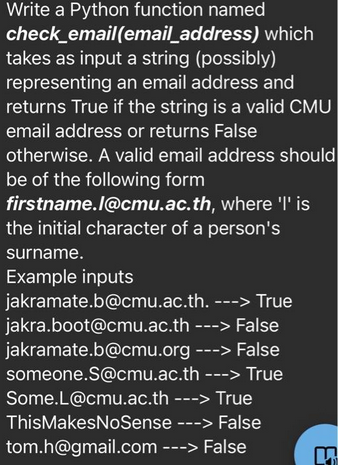
Database System Concepts
7th Edition
ISBN: 9780078022159
Author: Abraham Silberschatz Professor, Henry F. Korth, S. Sudarshan
Publisher: McGraw-Hill Education
expand_more
expand_more
format_list_bulleted
Question

Transcribed Image Text:Write a Python function named
check_email(email_address)
takes as input a string (possibly)
representing
an email address and
returns True if the string is a valid CMU
email address or returns False
otherwise. A valid email address should
be of the following form
firstname.l@cmu.ac.th, where 'I' is
the initial character of a person's
which
surname.
Example inputs
jakramate.b@cmu.ac.th. ---> True
jakra.boot@cmu.ac.th
jakramate.b@cmu.org
someone.S@cmu.ac.th
---> False
---> False
---> True
Some.L@cmu.ac.th ---> True
ThisMakesNoSense
---> False
tom.h@gmail.com ---> False
n
Expert Solution
This question has been solved!
Explore an expertly crafted, step-by-step solution for a thorough understanding of key concepts.
Step by stepSolved in 4 steps with 2 images

Knowledge Booster
Learn more about
Need a deep-dive on the concept behind this application? Look no further. Learn more about this topic, computer-science and related others by exploring similar questions and additional content below.Similar questions
- Consider following function that returns True if the string s could be an email address otherwise False. For this problem the function should return True if the string contains at least one "@" symbol. def is_email(s): if return True else: return False In the space below fill in the blank with a Boolean expression complete the function: Enter your answer herearrow_forwardIn program language C: The problem is to write a program that counts the number of letters, digits, other characters, and total characters from the input. If the user does not provide any additional command-line arguments, count the occurrences from standard input. If there is an additional command-line argument, count the occurrences in the string provided on the command line. It must use two functions: one that calculates the counts from standard input, and another that calculates the counts from a string (in this case you'll want to pass argv[1] to the latter function, if argv[1] exists). In main(), check the number of command line arguments to see which function to call, call the appropriate function to get the counts, and then print out the counts in main(). Each function should require you to return multiple values. The program must use two of the following strategies, one for each of the function implementations: - Create variables in main() that will store the counts and pass…arrow_forwardHow can I write a python program with a main function that imports a custom module file. The custom module file defines a function that takes the radius of a circle as its only parameter. In the module's custom function: calculate the area and circumference of the circle and use an f-string to print one precisely formatted line as follows: the radius should display centered with one decimal place in a column 8-characters wide. the area should be centered with four decimals in a column 12-characters wide. the circumference should also be centered with four decimals in a column 12-characters wide. outputs in the thousands should display commas. In the main function: print headings for the columns with the same alignments and widths. run a loop that will go through seven iterations. inside the loop generate a random integer from 40-80, inclusive. execute the function in the custom module with the random integer as its argument.arrow_forward
- in c programing with User-Defined Functions Remove all non-alphabetic characters Write a program that removes all non-alphabetic characters from the given input. Assume the input string will not exceed 50 characters. Ex: If the input is: -Hello, 1 world$! the output is: Helloworld The program must define and call a function named RemoveNonAlpha that takes two strings as parameters: userString and userStringAlphaOnly. userString is the user specified string from the program input. Function RemoveNonAlpha() then assigns userStringAlphaOnly with the user specified string without any non-alphabetic characters.void RemoveNonAlpha(char userString[], char userStringAlphaOnly[])arrow_forwardpython: Create a function called myemail that takes two arguments: a first name and a last name, and returns a Blue Ridge email address in lower case. The email is made by taking the first letter of the first name and the first 5 letters of the last name and adding 01 and @my.blueridgectc.edu to the end. For example, the function call: myemail('Amelia','Earhart') should return aearha01@my.blueridgectc.eduarrow_forward
arrow_back_ios
arrow_forward_ios
Recommended textbooks for you
 Database System ConceptsComputer ScienceISBN:9780078022159Author:Abraham Silberschatz Professor, Henry F. Korth, S. SudarshanPublisher:McGraw-Hill Education
Database System ConceptsComputer ScienceISBN:9780078022159Author:Abraham Silberschatz Professor, Henry F. Korth, S. SudarshanPublisher:McGraw-Hill Education Starting Out with Python (4th Edition)Computer ScienceISBN:9780134444321Author:Tony GaddisPublisher:PEARSON
Starting Out with Python (4th Edition)Computer ScienceISBN:9780134444321Author:Tony GaddisPublisher:PEARSON Digital Fundamentals (11th Edition)Computer ScienceISBN:9780132737968Author:Thomas L. FloydPublisher:PEARSON
Digital Fundamentals (11th Edition)Computer ScienceISBN:9780132737968Author:Thomas L. FloydPublisher:PEARSON C How to Program (8th Edition)Computer ScienceISBN:9780133976892Author:Paul J. Deitel, Harvey DeitelPublisher:PEARSON
C How to Program (8th Edition)Computer ScienceISBN:9780133976892Author:Paul J. Deitel, Harvey DeitelPublisher:PEARSON Database Systems: Design, Implementation, & Manag...Computer ScienceISBN:9781337627900Author:Carlos Coronel, Steven MorrisPublisher:Cengage Learning
Database Systems: Design, Implementation, & Manag...Computer ScienceISBN:9781337627900Author:Carlos Coronel, Steven MorrisPublisher:Cengage Learning Programmable Logic ControllersComputer ScienceISBN:9780073373843Author:Frank D. PetruzellaPublisher:McGraw-Hill Education
Programmable Logic ControllersComputer ScienceISBN:9780073373843Author:Frank D. PetruzellaPublisher:McGraw-Hill Education

Database System Concepts
Computer Science
ISBN:9780078022159
Author:Abraham Silberschatz Professor, Henry F. Korth, S. Sudarshan
Publisher:McGraw-Hill Education

Starting Out with Python (4th Edition)
Computer Science
ISBN:9780134444321
Author:Tony Gaddis
Publisher:PEARSON

Digital Fundamentals (11th Edition)
Computer Science
ISBN:9780132737968
Author:Thomas L. Floyd
Publisher:PEARSON

C How to Program (8th Edition)
Computer Science
ISBN:9780133976892
Author:Paul J. Deitel, Harvey Deitel
Publisher:PEARSON

Database Systems: Design, Implementation, & Manag...
Computer Science
ISBN:9781337627900
Author:Carlos Coronel, Steven Morris
Publisher:Cengage Learning

Programmable Logic Controllers
Computer Science
ISBN:9780073373843
Author:Frank D. Petruzella
Publisher:McGraw-Hill Education